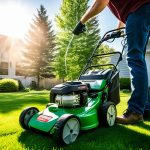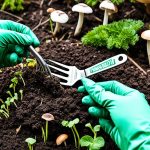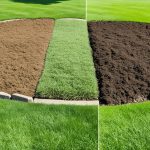Maintaining a beautiful lawn while conserving resources can be challenging for many homeowners. Proper watering practices not only keep your grass healthy but also reduce waste and save money on utility bills. Effective watering techniques allow you to maintain a lush lawn without spending excessive time or money.
With water costs rising and environmental concerns growing, smart irrigation strategies have become essential for responsible lawn care. These practical watering tips will help you achieve better results with less effort, ensuring your lawn stays green throughout the seasons without unnecessary expense or effort.
1) Water early in the morning to reduce evaporation
The best time to water your lawn is between 4 am and 10 am. During these early hours, temperatures are cooler and wind speeds are typically lower, creating ideal conditions for watering.
Early morning watering allows moisture to soak into the soil before the heat of the day begins. When you water during midday, up to 30% of water can be lost to evaporation, making morning watering far more effective.
Your grass needs time to dry before evening. Watering late in the day or at night keeps the lawn wet for extended periods, which can lead to fungal diseases and other lawn problems.
If you cannot water in the morning, late afternoon (4 pm to 6 pm) is the next best option. This gives the grass blades time to dry before nightfall while still avoiding the peak heat hours.
Automatic timers can help maintain a consistent early morning watering schedule. Many smart irrigation systems can be programmed to start in the early hours without requiring you to wake up at dawn.
2) Use a drip irrigation system for precise watering
Drip irrigation systems deliver water directly to plant roots rather than spraying it across the entire lawn. This targeted approach can reduce water usage by up to 60% compared to traditional sprinklers.
These systems consist of small tubes with emitters that release water slowly at the base of plants. The slow release allows soil to absorb water properly, preventing runoff and evaporation that often occurs with standard watering methods.
Installing a drip system isn’t as complicated as many homeowners believe. Most garden centres offer kits with simple instructions, and many systems can connect directly to existing outdoor taps.
For flower beds and vegetable gardens, drip lines can be hidden under mulch for a tidy appearance. For larger lawns, subsurface drip irrigation tubes can be installed below the grass root zone.
The initial investment pays for itself through lower water bills and healthier plants. Most systems cost between £50-£200 depending on the size of your garden, but can save hundreds in water costs annually.
Timer attachments can further enhance efficiency by automating the watering schedule. This means your plants receive consistent moisture even when you’re away from home.
3) Apply a thick layer of mulch to retain soil moisture
Adding mulch around your plants is one of the most effective ways to reduce water usage in your garden. A 5-8 cm layer of mulch acts as a protective barrier that slows evaporation from the soil surface. This simple step can reduce water needs by up to 30%.
Organic mulches like bark chips, straw, or compost work exceptionally well. They gradually break down, improving soil structure and adding nutrients as they decompose. Wood chips are particularly good for shrub beds and trees.
The timing of mulch application matters too. It’s best to apply mulch in late spring after soil has warmed, but before summer heat intensifies. Ensure the soil is moist before applying mulch to lock in that valuable moisture.
Keep mulch 5-7 cm away from plant stems and tree trunks to prevent rot and pest problems. This creates a protective ring that allows proper air circulation while still conserving moisture.
Refresh your mulch layer annually as it breaks down over time. Many gardeners find spring and autumn are ideal times to check mulch depth and top up as needed.
4) Check soil moisture with a probe before watering
Watering your lawn based on a schedule can lead to waste. A soil moisture probe offers a simple solution to this problem by helping you determine when your lawn actually needs water.
These inexpensive tools can be purchased at any garden centre. To use one, simply insert the probe about 15 cm into the soil. Many probes have a colour indicator that shows whether the soil is dry, moist or wet.
The ideal time to water is when the probe indicates the soil is on the dry side of moist. This prevents both under-watering and over-watering, which can damage grass roots and waste water.
Testing multiple areas of your lawn is important. Soil conditions can vary across your garden due to sun exposure, soil type and drainage patterns. Areas in full sun typically dry out faster than shaded spots.
Regular use of a moisture probe can reduce your water usage by up to 30%. This translates to lower water bills and a healthier lawn that develops deeper roots as it adapts to more efficient watering practices.
5) Group plants with similar water needs together
Planning your garden with water needs in mind saves time and reduces waste. When plants with similar requirements grow near each other, you can water them all at once with the same amount.
This approach is called hydrozoning. It prevents both overwatering and underwatering, which can stress or kill plants that have different needs from their neighbours.
For example, place thirsty plants like hydrangeas and certain vegetables together in one section. Create another area for drought-resistant plants such as lavender and rosemary that need less frequent watering.
Consider your garden’s natural conditions when planning these zones. Areas that receive more shade typically retain moisture longer than sunny spots.
Native plants often have similar water requirements and work well together. They’ve adapted to local rainfall patterns and usually need less supplemental watering once established.
Remember to check the specific needs of each plant before grouping them. Some plants might appear similar but have vastly different water requirements.
Your irrigation system can be adjusted accordingly for each zone, delivering exactly what each group needs without waste.
6) Use rainwater harvesting barrels to save water
Rainwater harvesting barrels offer a simple way to collect and store rainwater from your roof. These containers connect to your downspouts and capture water that would otherwise go to waste.
A standard rain barrel holds about 200-300 litres of water, which adds up quickly during rainy periods. This stored water is perfect for garden irrigation and can significantly reduce your water bill during dry spells.
Setting up a rain barrel system is straightforward. You’ll need a barrel, a diverter for your downspout, and a spigot for accessing the water. Many garden centres and hardware shops sell complete kits with all necessary parts.
Position your rain barrels on level ground and elevate them slightly on blocks to improve water pressure. Place a mesh screen over the top to prevent leaves and debris from entering the barrel.
During winter, empty and disconnect your rain barrels to prevent freezing damage. Store them upside down until spring when you can reconnect them for the rainy season.
7) Adjust sprinklers to avoid watering pavements
Poorly aligned sprinklers waste water and money when they spray driveways, paths and roads instead of your lawn. This common problem can increase water bills unnecessarily while doing nothing for your garden.
Take time to inspect your sprinklers while they’re running. Look for any that are shooting water onto hard surfaces and adjust their spray patterns or positions accordingly.
Some sprinkler heads can be fine-tuned by turning the adjustment screw or ring to change the arc or distance of the spray. Others might need to be physically repositioned to direct water only where it’s needed.
Consider installing sprinkler heads with adjustable patterns that can be shaped to fit your lawn’s exact dimensions. These allow you to create custom spray shapes that avoid pavements completely.
Half-circle and quarter-circle sprinkler heads are excellent choices for lawn areas that border pavements. They deliver water precisely where needed without wasteful overspray.
Remember that water running off pavements often carries fertilisers and chemicals into storm drains, potentially harming local waterways. Proper sprinkler alignment helps protect the environment too.
8) Aerate your lawn annually to improve water absorption
Aeration involves creating small holes in your soil to allow air, water, and nutrients to penetrate the grass roots. This process helps the roots grow deeply and produce a stronger, more vigorous lawn. Many homeowners overlook this essential maintenance task.
When soil becomes compacted, water runs off instead of soaking in where it’s needed. Aeration solves this problem by creating pathways for water to reach the root zone. The best time to aerate cool-season grasses is early autumn, while warm-season grasses benefit from spring aeration.
You can rent an aerator from a garden centre or hire a lawn care service to do the job. Core aerators, which remove plugs of soil, are more effective than spike aerators that simply poke holes in the ground.
After aeration, your lawn will absorb water more efficiently, reducing the amount you need to apply. This not only saves water but also reduces your water bill. The improved absorption also helps prevent puddles and runoff during heavy rainfall.
For the best results, consider top dressing with compost after aeration. This introduces beneficial microorganisms and organic matter into the soil profile, further enhancing water retention capabilities.
Understanding Optimal Lawn Watering
Proper watering techniques are essential for maintaining a healthy lawn while conserving resources. The right approach depends on several environmental factors and can help prevent common problems that lead to water waste and lawn damage.
Key Factors Affecting Water Absorption
Soil type significantly influences how water moves through your lawn. Clay soils hold water longer but absorb it slowly, while sandy soils drain quickly but don’t retain moisture well. Loamy soils offer the best balance for most lawns.
Weather conditions play a major role in watering needs. During hot periods, water early morning (4-7 am) to reduce evaporation. In cooler weather, reduce frequency rather than duration of watering.
Grass species have different water requirements:
- Cool-season grasses (fescue, ryegrass) need more frequent watering
- Warm-season grasses (Bermuda, zoysia) are more drought-tolerant
Lawn age matters too. Newly seeded areas need light, frequent watering, while established lawns benefit from deeper, less frequent soaking that encourages deep root growth.
Common Watering Mistakes to Avoid
Overwatering is perhaps the most wasteful mistake. Signs include soggy soil, fungal growth, and weeds. Most lawns need only 2.5-4 cm of water per week including rainfall.
Watering at the wrong time can be problematic. Evening watering leaves grass wet overnight, promoting disease. Midday watering wastes water through evaporation before it reaches roots.
Inconsistent watering creates stress for grass plants. Establish a regular schedule based on your lawn’s needs rather than watering only when grass looks dry.
Using incorrect equipment leads to waste. Replace leaky hoses and broken sprinkler heads promptly. Consider installing a rain sensor or smart timer to automatically adjust watering based on local conditions.
Fixed watering patterns often miss spots or overwater others. Move sprinklers regularly or install systems that provide even coverage across your entire lawn.
Improving Water Efficiency in Your Garden
Water efficiency saves resources and promotes healthier plant growth. By selecting appropriate tools and watering at optimal times, you can reduce waste while maintaining a beautiful garden.
Selecting the Right Irrigation Tools
Drip irrigation systems deliver water directly to plant roots, reducing evaporation and runoff. These systems use 30-50% less water than traditional sprinklers and can be set on timers for consistent application.
Soaker hoses work similarly by releasing water slowly at soil level. They’re ideal for flower beds and vegetable gardens where direct watering is beneficial.
For container gardens, consider self-watering pots that store water in a reservoir beneath the soil. Plants draw moisture as needed, reducing the frequency of watering.
Rain barrels capture free water that would otherwise run off your property. Connect them to downspouts to collect rainfall for later use in the garden.
Smart controllers adjust watering schedules based on weather conditions and soil moisture. Though initially more expensive, they typically pay for themselves within two seasons through water savings.
Timing Your Watering for Best Results
Early morning watering (4-7 am) is ideal as temperatures are cooler and wind is minimal. This timing reduces evaporation and allows foliage to dry before evening, preventing fungal diseases.
Water deeply but less frequently to encourage deeper root growth. Most established lawns need only 2.5 cm of water per week, including rainfall.
Use the footprint test to check if your lawn needs water: walk across your grass and if footprints remain visible, it’s time to water.
Adjust your watering schedule seasonally. Plants need less water during cooler months and more during hot periods. Skip watering after substantial rainfall.
Consider the specific needs of different plants. Established trees and shrubs require less frequent watering than vegetables or new plantings.





